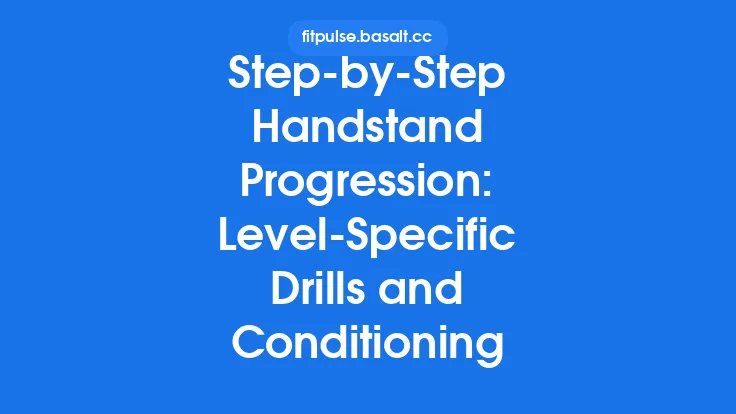Plyometric and agility training are powerful tools for athletes, coaches, and fitness enthusiasts who want to boost explosive power, speed, and reactive ability without relying on any external equipment. By leveraging the body’s own weight and the ground reaction forces generated during rapid movements, you can create a highly effective, equipment‑agnostic program that fits into any training schedule—whether you’re working out in a small apartment, a park, or a gym‑free environment. This article walks you through the science, programming principles, progression strategies, and practical drill selections needed to design a comprehensive plyometric and agility regimen that delivers lasting performance gains.
Understanding the Foundations: Plyometrics vs. Agility
Plyometrics (also known as “jump training”) focus on the stretch‑shortening cycle (SSC) of muscle fibers. By rapidly lengthening a muscle (eccentric phase) and then immediately shortening it (concentric phase), you train the neuromuscular system to produce maximal force in the shortest possible time. The primary outcomes are increased vertical and horizontal power, improved rate of force development (RFD), and enhanced neuromuscular efficiency.
Agility refers to the ability to change direction quickly and accurately while maintaining balance and control. It integrates speed, coordination, proprioception, and decision‑making. While agility drills often involve rapid footwork and directional changes, they also rely heavily on the same SSC mechanisms emphasized in plyometrics.
Both domains share common physiological demands:
| Component | Plyometrics | Agility |
|---|---|---|
| Primary Energy System | Phosphagen (ATP‑CP) | Phosphagen + Anaerobic Glycolysis |
| Key Muscle Action | Explosive concentric after eccentric stretch | Rapid deceleration/acceleration and lateral force production |
| Neuromuscular Goal | Maximize RFD | Optimize motor pattern sequencing and reaction time |
| Typical Load | Bodyweight or minimal external load | Bodyweight, directional cues, and reactive stimuli |
Understanding these overlaps helps you design drills that simultaneously develop power and change‑of‑direction proficiency.
Core Programming Variables
When constructing an equipment‑free plyometric‑agility program, treat it like any other periodized training block. The five primary variables—intensity, volume, frequency, rest, and specificity—must be balanced to promote adaptation while minimizing injury risk.
1. Intensity (Force & Velocity)
- Intensity in plyometrics is expressed as the height of the jump, depth of a drop, or speed of a directional change. For agility, intensity is reflected in the rapidity of foot placement and the angle of direction change.
- Guideline: Begin with low‑to‑moderate intensity (e.g., squat jumps, low‑height box jumps using a sturdy step) and progress to high‑intensity movements (e.g., depth jumps from 12‑18 inches, single‑leg bounds, or 180° cuts) as technique solidifies.
2. Volume (Reps & Sets)
- Plyometric volume is typically measured in “foot contacts” (each landing counts as one contact). A beginner may start with 40–60 contacts per session, while an advanced athlete can handle 120–180 contacts.
- Agility volume is quantified by the number of repetitions of a drill (e.g., 6–8 sprints of a 5‑10 m shuttle) or total time spent (e.g., 10 minutes of ladder work).
3. Frequency
- Optimal frequency for most athletes is 2–3 sessions per week, spaced at least 48 hours apart to allow for neuromuscular recovery.
- Special considerations: If the program is part of a larger training split (e.g., strength on Monday, plyo/agility on Tuesday), ensure the overall weekly load does not exceed the athlete’s recovery capacity.
4. Rest Intervals
- Between contacts: 30–90 seconds for high‑intensity jumps; shorter (10–30 seconds) for low‑intensity or skill‑focused drills.
- Between sets: 2–4 minutes for maximal power sets; 1–2 minutes for agility circuits.
- Between sessions: Incorporate at least one full rest day or a low‑intensity active recovery day (e.g., mobility work) after a heavy plyometric day.
5. Specificity
- Align drill selection with the sport or activity’s movement patterns. A basketball player benefits from vertical jumps and lateral shuffles, while a soccer player needs horizontal bounds and multi‑directional cuts.
Periodization Strategies for Equipment‑Agnostic Plyo‑Agility
A well‑structured periodization model ensures progressive overload while safeguarding against overuse injuries. Below are three common frameworks adaptable to any training calendar.
Linear Periodization
- Phase 1 (Weeks 1‑4): Emphasis on technique, low intensity, moderate volume. Example: 3 sets of 8 squat jumps, 4 × 10 m cone shuffles.
- Phase 2 (Weeks 5‑8): Increase intensity (higher jumps, deeper cuts) while reducing volume slightly. Example: 4 sets of 6 depth jumps, 5 × 15 m lateral bounds.
- Phase 3 (Weeks 9‑12): Peak phase with maximal intensity, low volume, and sport‑specific agility patterns. Example: 3 sets of 4 single‑leg bounds, 6 × 20 m pro‑agility shuttle.
Undulating (Non‑Linear) Periodization
- Rotate intensity and volume daily or weekly. For instance:
- Monday: High‑intensity plyometrics (depth jumps, 3 × 5 reps).
- Wednesday: Moderate‑intensity agility (cone drills, 4 × 30 seconds).
- Friday: Low‑intensity power endurance (continuous bounding for 60 seconds).
Block Periodization
- Accumulation Block (2‑3 weeks): High volume, low intensity to build work capacity.
- Transmutation Block (2‑3 weeks): Moderate volume, moderate intensity focusing on conversion of capacity to power.
- Realization Block (1‑2 weeks): Low volume, high intensity to crystallize peak performance.
Select the model that best aligns with competition schedules, athlete experience, and overall training load.
Designing a Single Session: Template Walkthrough
Below is a step‑by‑step blueprint for a 45‑minute equipment‑free plyometric‑agility session. Adjust the numbers based on the athlete’s level and the periodization phase.
- Dynamic Warm‑Up (10 min)
- 2 × 30 seconds of high‑knee runs
- 2 × 30 seconds of butt‑kickers
- 3 × 10 m A‑skips
- 3 × 10 m B‑skips
- 2 × 10 seconds of ankle‑to‑glute bridges (to prime the posterior chain)
- Neuromuscular Activation (5 min)
- Pogo Jumps: 2 × 20 contacts, 30 seconds rest
- Bounding Walks: 2 × 10 m, focus on minimal ground contact time
- Primary Plyometric Block (15 min)
- Exercise A – Squat Jump: 3 × 8 reps, 60 seconds rest
- Exercise B – Lateral Skater Jump: 3 × 6 reps per side, 60 seconds rest
- Exercise C – Depth Jump (from a 12‑inch step): 3 × 5 reps, 90 seconds rest
- Agility Circuit (10 min)
- Set up 5 cones in a “T” pattern (10 m spacing). Perform:
- Sprint → Backpedal → Lateral Shuffle → Sprint (one full circuit)
- Reps: 4 × circuit, 45 seconds rest between circuits
- Cool‑Down & Mobility (5 min)
- Static hamstring stretch (30 seconds each side)
- Hip flexor stretch (30 seconds each side)
- Calf stretch against a wall (30 seconds each side)
Key Takeaway: The session balances high‑intensity power work with directional change drills, while the warm‑up and cool‑down protect joints and improve movement quality.
Progression Pathways: From Beginner to Advanced
Beginner (0‑3 months)
- Focus: Master landing mechanics (soft knees, neutral spine), develop proprioception.
- Drills: Squat jumps, low‑height step‑ups, forward/backward shuffles, 5‑10 m cone drills.
- Progression Cue: Increase height of jumps by 2‑4 inches or add a single‑leg variation once landing is stable.
Intermediate (3‑9 months)
- Focus: Introduce eccentric overload, increase directional complexity.
- Drills: Depth jumps (12‑18 inches), lateral bounds, 180° cuts, “L‑drill” agility pattern.
- Progression Cue: Reduce ground contact time (aim for <0.2 seconds) and incorporate reactive cues (e.g., partner calls, visual signals).
Advanced (9+ months)
- Focus: Maximize power output, integrate sport‑specific decision making.
- Drills: Single‑leg depth jumps, multi‑directional bounding (e.g., “X‑pattern”), pro‑agility shuttle with random start cues, plyometric circuits with minimal rest.
- Progression Cue: Add load via weighted vest (≤10% bodyweight) only if the athlete has a solid foundation and the sport permits.
Safety Considerations & Injury Prevention
- Landing Mechanics: Emphasize “soft” landings—knees bent, hips hinged, and feet landing under the center of mass. This reduces joint stress.
- Surface Selection: Perform drills on shock‑absorbing surfaces (grass, rubber mat, wooden floor). Avoid concrete or overly hard surfaces.
- Progressive Load: Never jump from a height greater than 30 % of the athlete’s maximal squat depth without prior conditioning.
- Monitoring Fatigue: Use a simple RPE (Rate of Perceived Exertion) scale after each block. If RPE exceeds 7/10 consistently, reduce volume or increase rest.
- Pre‑Existing Conditions: Athletes with knee ligament issues, Achilles tendinopathy, or chronic low back pain should obtain clearance before high‑impact plyometrics.
Integrating Plyometric‑Agility Work into a Holistic Training Plan
While this article isolates plyometric and agility programming, real‑world training rarely exists in a vacuum. Here’s how to weave these sessions into broader periodized plans:
| Training Component | Weekly Frequency | Example Placement |
|---|---|---|
| Strength (e.g., squat, deadlift) | 2–3 days | Monday, Thursday |
| Plyometric‑Agility | 2 days | Tuesday, Friday |
| Aerobic/Endurance | 1–2 days | Wednesday, Saturday (low‑intensity) |
| Mobility & Recovery | Daily (short) | Post‑session stretching, foam rolling |
Sequencing Tip: Schedule plyometric/agility sessions after a light or rest day, not immediately after heavy lower‑body strength work, to preserve neuromuscular quality.
Assessment & Tracking Progress
To ensure the program is delivering measurable improvements, incorporate objective testing every 4–6 weeks.
- Vertical Jump Test: Use a wall or a simple jump mat. Record height; aim for 2–5 % increase per mesocycle.
- Pro‑Agility Shuttle (5‑10‑5): Time the drill; a 0.05‑second reduction is a meaningful gain for most athletes.
- Reactive Agility Test: Partner or light cue triggers a direction change; track reaction time and completion time.
- Contact Time Measurement: If a smartphone app or simple stopwatch is available, measure ground contact time during a series of jumps; reductions indicate improved SSC efficiency.
Log results in a training journal alongside subjective notes (energy, soreness, motivation) to fine‑tune volume and intensity.
Frequently Asked Questions
Q: Can I use household items (e.g., a sturdy chair) to increase difficulty?
A: While the focus is on equipment‑agnostic drills, a stable chair can serve as a low platform for step‑ups or depth jumps. Ensure the surface is non‑slippery and can support the athlete’s weight safely.
Q: How many plyometric sessions are too many?
A: For most individuals, exceeding three high‑intensity sessions per week raises injury risk. If you need more frequency, alternate high‑intensity days with low‑intensity “technique” days that emphasize form over load.
Q: Is it okay to combine plyometrics with HIIT?
A: Yes, but keep them separate within a session (e.g., plyometrics first, HIIT later) or on different days to avoid excessive neuromuscular fatigue.
Q: What if I have limited space?
A: Many drills require only a 2 × 2 m area (e.g., squat jumps, single‑leg hops). For agility, use tape or small markers to create mini‑cones; the pattern can be scaled down without losing training value.
Final Thoughts
Designing plyometric and agility drills without equipment is not a compromise—it’s an opportunity to harness the body’s innate capacity for explosive movement. By applying sound programming principles—balancing intensity, volume, frequency, rest, and specificity—you can craft a progressive, safe, and sport‑specific regimen that fits any environment. Consistent assessment, attention to technique, and thoughtful integration with other training modalities will ensure that athletes of all levels continue to develop power, speed, and reactive agility for years to come.





